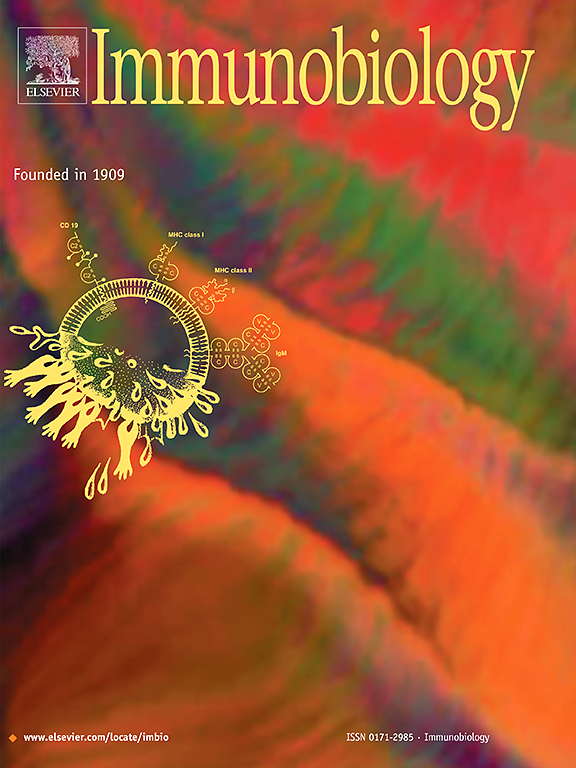Phellodendrine chloride alleviates gouty arthritis through IL-6/STAT3 signaling pathway
IF 2.3
4区 医学
Q3 IMMUNOLOGY
引用次数: 0
Abstract
Background
Phellodendrine, a primary bioactive constituent of Phellodendron chinense Schneid (PCS), is crucial in its pharmacological profile. Phellodendrine exhibits potent anti-nephritic properties and demonstrates a marked inhibitory effect on the cellular immune response. However, the effects of phellodendrine on proteoglycan depletion and cartilage degeneration in gouty arthritis remain insufficiently understood. Therefore, the objective of this study is to elucidate the therapeutic potential and underlying mechanisms of phellodendrine chloride (PC) in the treatment of gouty arthritis.
Methods
A monosodium urate (MSU)-induced arthritis model in rats, along with a peritonitis model in mice, was developed, in combination with a chondrocyte model. Neutrophil proportions were quantified using flow cytometry. The expression levels of MMP-3, STAT3, and phosphorylated STAT3 (p-STAT3) in chondrocytes were determined by Western blot analysis. Proteoglycan levels in chondrocytes were assessed using toluidine blue staining and quantitative reverse transcription PCR (qRT-PCR). Joint swelling rates were monitored at 0–24 h in rats, and histopathological changes in joint tissues were subsequently analyzed.
Results
Phellodendrine chloride mitigated the rise in neutrophil proportions within MSU-induced peritoneal lavage fluid in mice and decreased inflammatory cell infiltration in rat ankle tissues. Treatment with phellodendrine chloride led to a downregulation of MMP-3 protein levels and inhibited IL-1β-induced proteoglycan degradation in chondrocytes. Additionally, results from experiments combining IL-1β with AG490 or IL-6 demonstrated that phellodendrine chloride attenuated IL-1β-induced MMP-3 expression and proteoglycan degradation.
Conclusion
Our findings suggest that phellodendrine chloride mitigates gouty arthritis (GA) by modulating the IL-6/STAT3 signaling pathway.
氯化黄柏碱通过IL-6/STAT3信号通路缓解痛风性关节炎
黄柏碱是黄柏的主要生物活性成分,在其药理研究中具有重要意义。黄柏碱具有强效的抗肾病特性,对细胞免疫反应有明显的抑制作用。然而,黄柏碱对痛风性关节炎的蛋白聚糖耗损和软骨变性的影响仍未得到充分的了解。因此,本研究的目的是阐明氯化黄柏碱(PC)治疗痛风性关节炎的治疗潜力和潜在机制。方法建立尿酸钠(MSU)诱导的大鼠关节炎模型和小鼠腹膜炎模型,并结合软骨细胞模型。流式细胞术定量中性粒细胞比例。Western blot检测软骨细胞中MMP-3、STAT3及磷酸化STAT3 (p-STAT3)的表达水平。采用甲苯胺蓝染色和定量反转录PCR (qRT-PCR)评估软骨细胞中的蛋白聚糖水平。在0 ~ 24 h监测大鼠关节肿胀率,随后分析关节组织的组织病理学变化。结果氯树碱能减轻msu诱导小鼠腹膜灌洗液中中性粒细胞比例的升高,并能减少大鼠踝关节组织中炎症细胞的浸润。用氯化黄柏碱治疗导致MMP-3蛋白水平下调,并抑制il -1β诱导的软骨细胞蛋白聚糖降解。此外,将IL-1β与AG490或IL-6联合使用的实验结果表明,氯化黄柏碱可减弱IL-1β诱导的MMP-3表达和蛋白多糖降解。结论氯黄柏碱通过调节IL-6/STAT3信号通路减轻痛风性关节炎(GA)。
本文章由计算机程序翻译,如有差异,请以英文原文为准。
求助全文
约1分钟内获得全文
求助全文
来源期刊

Immunobiology
医学-免疫学
CiteScore
5.00
自引率
3.60%
发文量
108
审稿时长
55 days
期刊介绍:
Immunobiology is a peer-reviewed journal that publishes highly innovative research approaches for a wide range of immunological subjects, including
• Innate Immunity,
• Adaptive Immunity,
• Complement Biology,
• Macrophage and Dendritic Cell Biology,
• Parasite Immunology,
• Tumour Immunology,
• Clinical Immunology,
• Immunogenetics,
• Immunotherapy and
• Immunopathology of infectious, allergic and autoimmune disease.
 求助内容:
求助内容: 应助结果提醒方式:
应助结果提醒方式:


